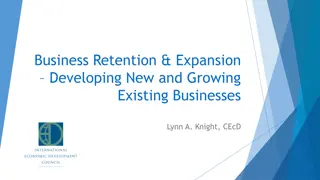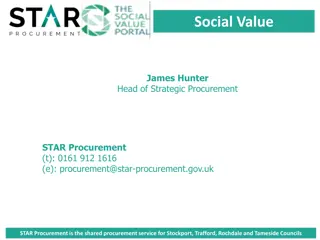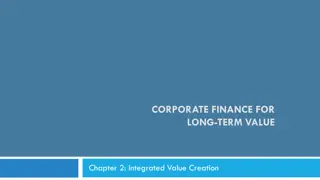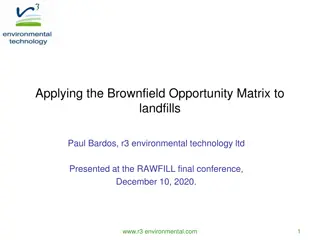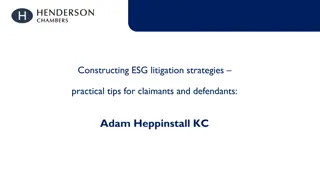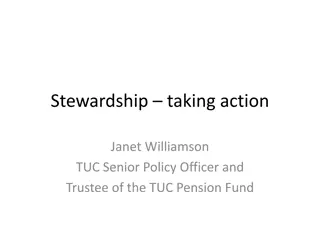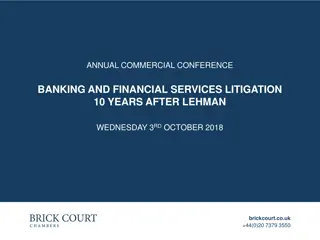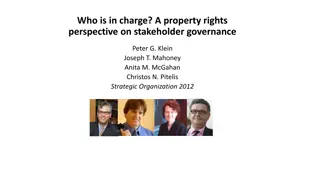Maximizing Shareholder Value Creation Through Strategic Business Practices
Explore the concept of shareholder value creation, the importance of generating revenues exceeding economic costs, and meeting shareholders' expectations. Learn about Economic Value Added (EVA), key value drivers, aligning strategy with value creation, and essential factors for overall business success. Dive into strategies for competitive advantage, operational excellence, growth, risk management, and more in this insightful discussion on fostering value in corporate environments.
Download Presentation

Please find below an Image/Link to download the presentation.
The content on the website is provided AS IS for your information and personal use only. It may not be sold, licensed, or shared on other websites without obtaining consent from the author.If you encounter any issues during the download, it is possible that the publisher has removed the file from their server.
You are allowed to download the files provided on this website for personal or commercial use, subject to the condition that they are used lawfully. All files are the property of their respective owners.
The content on the website is provided AS IS for your information and personal use only. It may not be sold, licensed, or shared on other websites without obtaining consent from the author.
E N D
Presentation Transcript
Shareholder value creation Shareholder value creation Case study discussion Case study discussion Priyanka Darshana ACMA (UK),MBA (Aus), ACMA (SL), CGMA, B.B Mgt (Kelaniya)
What is value What is value From the economist s viewpoint, value is created when management generates revenues over and above the economic costs to generate these revenues. Costs come from four sources: employee wages and benefits; material, supplies, and economic depreciation of physical assets; taxes; and the opportunity cost of using the capital.
Share holders expectation Share holders expectation Shareholders expect management to generate value over and above the costs of resources consumed, including the cost of using capital. If suppliers of capital do not receive a fair return to compensate them for the risk they are taking, they will withdraw their capital in search of better returns, since value will be lost. A company that is destroying value will always struggle to attract further capital to finance expansion, since it will be hamstrung by a share price that stands at a discount to the underlying value of its assets and by higher interest rates on debt or bank loans demanded by creditors.
Key value drivers Key value drivers The Rappaport model (1995)
Strategy & Execution should be aligned with Strategy & Execution should be aligned with value creation value creation Which Business Value creation Corporate strategy How to compete Value creation Competitive strategy Execution and measurement How to operate Value creation
Key value drivers in overall business Key value drivers in overall business perspective perspective % of innovation in the product or service portfolio % of new customers acquired % of loss customers % of products/market/key accounts discontinued Asset utilization Capital structure management and WACC Operational cash flow and working capital management Operational excellence in value chain of the company Growth in topline revenue, key markets and the customers Growth in operational margin Risk management and corporate governance framework
Section A Section A Carry out the situational analysis of the selected company or a specific SBU based on the Rappaport models key value drivers. Based on your analysis identify the current inadequacies of the business that block the long term share holder value creation. Proposed changes to the current system to overcome the inadequacies and improve the shareholder value.
Measurements of share holder value creation Measurements of share holder value creation Economic value added (EVA) Equity spread Total share holder return (TSR)
discussion discussion Is it wrong to maximise SHAREHOLDER VALUE ? What other matters should Corporate Leader consider ?
linkage between strategy and value creation linkage between strategy and value creation The first law is that management must create value for shareholders. The second law is that all other stakeholders should also be satisfied in a way that contributes to shareholder value.










